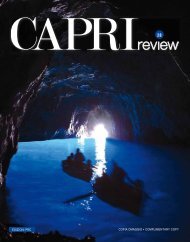OUR GUESTS: - Capri
OUR GUESTS: - Capri
OUR GUESTS: - Capri
Create successful ePaper yourself
Turn your PDF publications into a flip-book with our unique Google optimized e-Paper software.
FOLKLORE<br />
murriello”, I passi e i ritmi<br />
della Tarantella<br />
un piccolo sono frenetici<br />
e coinvolgenti.<br />
tamburo mu-<br />
The steps<br />
nito di sona- and rhythm<br />
of the Tarantella<br />
gli che emet-<br />
are frenetic<br />
te un tin- and irresistible.<br />
tinnìo e un suono frammisto<br />
quando viene colpito con la<br />
mano. Il “triccaballacche”, uno strumento<br />
composto di due martelletti di<br />
legno muniti di dischetti di latta che<br />
scorrono su un asse e colpiscono un<br />
martelletto centrale e fisso. Il “putipù”,<br />
un tamburo rudimentale perforato<br />
al centro da una cannuccia, che<br />
viene spinta a scatti provocando suoni<br />
striduli o laceranti. Lo “scetavaiasse”,<br />
un asse di legno che si appoggia alla<br />
spalla come un violino e un canna dentata,<br />
munita di dischetti di latta, che<br />
percorrendo l’asse emette un suono<br />
composito provocato dall’urto della<br />
dentellatura sul legno e dal tintinnìo<br />
dei dischetti.<br />
Sono strumenti poveri, privi di un suono<br />
melodico e di una musicalità, ma<br />
dotati di un forte impatto evocativo e di<br />
un fascino indiscusso. Strumenti capaci<br />
di imporre ritmi e cadenze. La Tarantella,<br />
così come il ballo di Sfessania<br />
suo progenitore, non è altro che questo:<br />
una serie di cadenze ritmiche e coinvolgenti<br />
su cui si innestano figure di danza.<br />
È l’immagine del popolo e dei suoi<br />
costumi, delle sue imperfezioni e delle<br />
sue passioni, del suo passato e del suo<br />
presente. Un ballo che vive della sua<br />
sacralità e delle sue tradizioni, come<br />
quella che considera il tamburello, per<br />
la sua forma e la sua qualità, il simbolo<br />
26<br />
del genitale femminile. Motivo per cui<br />
lo strumento è suonato solo da donne e<br />
bambini e mai da uomini.<br />
Tradizioni che affondano le loro radici<br />
nel tempo, che nascono nella leggenda,<br />
rivivono nei racconti e vengono<br />
tramandate fino ad oggi. La Tarantella<br />
del Ventesimo secolo non<br />
sarà mai come quella ballata dai greci<br />
o dai capresi sotto la dominazione<br />
spagnola. È un ballo che il tempo ha<br />
ingentilito, che si è fatto folklore e bene<br />
culturale. Ma nonostante ciò preserva,<br />
ancora oggi, il fascino di un<br />
tempo e quell’insolito richiamo all’istinto<br />
e alla natura, troppo umano per<br />
essere rinnegato.<br />
■<br />
Scialapopolo:<br />
Spirit of the Tarantella<br />
The Scialapopolo group was founded in 1933 by<br />
Costanzo Spadaro. He passed the baton to his<br />
nephew Costanzo, who upholds popular tradition by<br />
making music and putting on a thrilling show. Setting<br />
off from <strong>Capri</strong>, where the group originated and has<br />
enjoyed its greatest success, the Scialapopolo<br />
dancers and musicians have performed around the<br />
globe. They have also wowed audiences across the<br />
Atlantic, through Ingrid Bergman’s pirouettes and<br />
charity galas for UNICEF. The group has virtually<br />
toured the world but its throbbing heart is on <strong>Capri</strong><br />
where it gives captivating three-hour performances<br />
featuring up to 40 dancers. Scialapopolo alternates<br />
traditional Neapolitan songs with national and foreign<br />
compositions, finishing with the eagerly-awaited<br />
tarantellas. Listening to the group on <strong>Capri</strong> is like<br />
touching the island’s soul, getting in tune with its<br />
rhythms and reliving its traditions.<br />
ARCHIVIO SCIALAPOPOLO<br />
songs to foreign and national compositions,<br />
and they always finish with tarantellas. This<br />
dance expresses and encourages<br />
participation, gaiety and rapture, all of which<br />
are part of its atmosphere. The rhythm<br />
builds up, the music crescendos and the<br />
tarantella becomes the island’s theme<br />
music.<br />
A simple, basic melody generates so much<br />
euphoria. The main instruments are four:<br />
the tammurriello, a small tambourine with<br />
bells that jingle, producing a combination of<br />
sounds when it is struck with the hand. The<br />
triccaballacche, an instrument composed of<br />
two small wooden hammers fitted with small<br />
tin disks, which slide along a bar and strike<br />
a small hammer fixed in the middle. The<br />
putipù, a rudimentary drum with a piece of<br />
thin cane through the middle, which is<br />
pushed at intervals, making strident,<br />
piercing sounds. The scetavaiasse, a<br />
wooden bar that is rested on the shoulder<br />
like a violin and a toothed cane fitted with<br />
small tin disks, which as it moves along the<br />
bar produces a combination of sounds<br />
created by the teeth as they hit the wood<br />
and the jingling of the small metal disks.<br />
These are rudimentary instruments that do<br />
not produce melodic sounds or possess a<br />
musical quality; nevertheless, they are<br />
highly evocative and have an unmistakable<br />
charm. They are instruments capable of<br />
imposing a rhythm and a beat. The<br />
tarantella, like the sfessania before it, is<br />
simply this: a series of captivating rhythms<br />
on which various dance figures are based.<br />
This dance represents the people and their<br />
customs, their faults and their passions,<br />
their past and their present. It lives on<br />
through its sacrosanct traditions, such as<br />
the one that considers the<br />
tambourine to be symbolic of<br />
the female sexual organ, due<br />
to its shape and its particular<br />
quality. That’s why this<br />
instrument is played only by<br />
women and children, but never<br />
men.<br />
Traditions that go way back in<br />
time, that are born from legend,<br />
come alive in stories and are<br />
handed down to the present.<br />
The tarantella of this century<br />
will never be like the one<br />
danced by the Greeks or the<br />
inhabitants of <strong>Capri</strong> under<br />
Spanish rule. It is a dance that<br />
time has softened, that has<br />
become a part of folklore and<br />
our cultural heritage.<br />
Nonetheless, it still has its<br />
original fascination and that<br />
unusual appeal to the instincts<br />
and to nature, which are too<br />
human to be ignored.<br />
■







